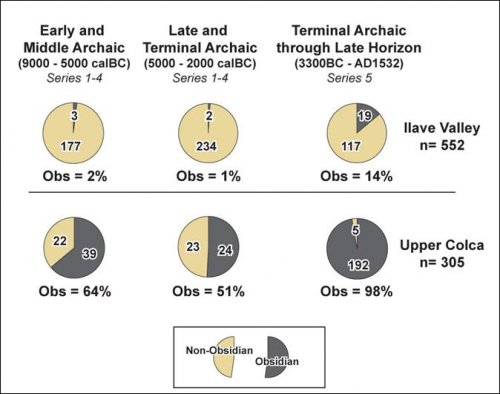3.4.4. The Ilave Valley and Jiskairumoko
Located in the Department of Puno in the western Lake Titicaca Basin, the Ilave river valley is an open, terraced river valley and it forms the highest volume river drainage to flow into Lake Titicaca from the west. Jiskairumoko (95-189) is the largest multicomponent Archaic/Formative site identified during survey and it lies 200 km from the Chivay obsidian source or 44 hours travel time across the expansive puna grasslands. Mark Aldenderfer conducted research in the Ilave valley from 1994 to 2002 including a pedestrian survey, a testing program, and excavation work (Aldenderfer 1997;Aldenderfer 1998). In 1997 and 1998 Cindy Klink conducted research in the Huenque drainage, a principal tributary that joins the Ilave from the south (Klink 2005;Klink 2006;Klink and Aldenderfer 1996). Nathan Craig excavated at the site of Jiskairumoko and tested at numerous other sites between 1999 and 2002 (Craig 1999;Craig 2005;Craig and Aldenderfer 2002;Craig and Aldenderfer In Press). Tripcevich conducted a viewshed analysis of sites in the Ilave drainage using data from the 1994 and 1995 Ilave valley survey (Tripcevich 2002).
IlaveValley
In the Ilave valley, obsidian was scarce prior to 3300 BCE, but it appears in a number of Terminal Archaic and Formative contexts after that date. Diagnostic projectile points from the Ilave area reveal a dramatic change in material type with the Terminal Archaic.
Figure 3-9. Comparison of projectile point counts in the Ilave Valley and the Upper Colca.
Using only diagnostic projectile points from the Klink and Aldenderfer (2005) point typology, these data reveal a shift to greater use of obsidian with series 5 projectile points. Following the point typology, all series 1 through 4 points are diagnostic to the Terminal Archaic or earlier, except for types 4C and 4E which have been excluded from this analysis. The lower part ofXFigure 3-9Xreveals data classified into the same three groups, but with data from the Chivay obsidian source area resulting from the 2003 Upper Colca project. Comparing these two datasets reveals that with the advent of Series 5 points in the Terminal Archaic after 3300 BCE there is a sudden upswing in obsidian use in the Ilave consumption zone that corresponds perfectly with a dramatic shift in projectile point production at the Chivay source area itself. There appear to have been pan-regional changes occurring with the widespread adoption of series 5 style projectile points, the use of obsidian, and these changes are possibly related to the greater use of the bow and arrow.
Jiskairumoko (95-189)
The site of Jiskairumoko was excavated using a broad, horizontal décapage technique between the years 1999 and 2002, and Craig's (2005) dissertation forms the site archive. Radiocarbon dates fromexcavation work at Jiskairumoko range from the Late-Terminal Archaic transition with a date of 4562±73bp(AA58476; 3520-3020 BCE)through to the end of the Early Formative, with a date of3240±70bp (Beta-97321; 1690-1390 BCE). Note that Craig (2005) has the Terminal Archaic dating to 3000-1500 BCE, while in the Upper Colca Project and in this dissertation the period dates to 3300 - 2000 BCE All references to the "Terminal Archaic" have been adjusted to the latter time range in this document unless otherwise noted.
Craig and Aldenderfer chemically characterized 68 bifacially-flaked obsidian tools from excavated contexts at Jiskairumoko (96% of all obsidian tools from Jiskairumoko) by sending these items to M. Steven Shackley at the UC Berkeley Archaeological XRF Lab(Craig 2005: 513, 908-916). The samples were compared with four geological samples that provided to Shackley from nodules that I had collected from Chivay source in 2003. Three of the nodules provided to Shackley were from the Maymeja area and one was from east of Cerro Hornillo. The XRF results showed that 97% of the Jiskairumoko obsidian tools (n = 66) were from the Chivay source and 3% (n = 2) were from the Alca source. These values diverge slightly from obsidian type distributions in the Titicaca Basin more generally (XTable 3-3X), where 90.5% (n = 466) of all of the obsidian artifacts tested to date from the Titicaca Basin are Chivay type. These data indicate that the people at Jiskairumoko were more intensively using Chivay obsidian in the Terminal Archaic and Early Formative than were Titicaca Basin residents over all, especially in contrast to the variety in obsidian types that emerge from samples dating to later times.
Obsidian artifacts from excavations at Jiskairumoko reveal that obsidian was used in similar proportions for projectile points from excavated contexts as for points from surface contexts in the Ilave valley. Craig(2005: 685)observes that 18% (n = 54) of the excavated Jiskairumoko projectile points are made from obsidian. He also notes that 50% of these have edge modification in the form of serration or denticulation while only 15% of non-obsidian points have edge treatment, a statistically very significant pattern that he attributes to the symbolic importance of this material. Obsidian was found, along with other lithics and a carved camelid effigy, in Burial 1 at Jiskairumoko in the grave of an elderly adult female with cranial deformation, a primary deposit dating to the Terminal Archaic or 3019-2859 cal BCE(Craig 2005: 680-682). Graves excavated in the Ilave valley area also contain a variety of non-local grave goods including obsidian, lapis, and gold, but non-local grave goods only occur in contexts dating to the Terminal Archaic and later.
